Organisational Behaviour: Influence, Motivation, and Teamwork
VerifiedAdded on 2023/06/17
|16
|4829
|193
Report
AI Summary
This report provides a comprehensive analysis of organisational behaviour within the context of Waitrose, a British supermarket chain. It explores how an organisation's culture, politics, and power dynamics influence individual and team behaviour and performance. The report evaluates content and process theories of motivation, such as Maslow's hierarchy of needs and Herzberg's two-factor theory, and examines motivational techniques for achieving organisational goals. It further demonstrates an understanding of the characteristics of effective and ineffective teams. Finally, the report applies concepts and philosophies of organisational behaviour to a given business situation, providing insights into how Waitrose can enhance its organisational effectiveness by leveraging these principles.
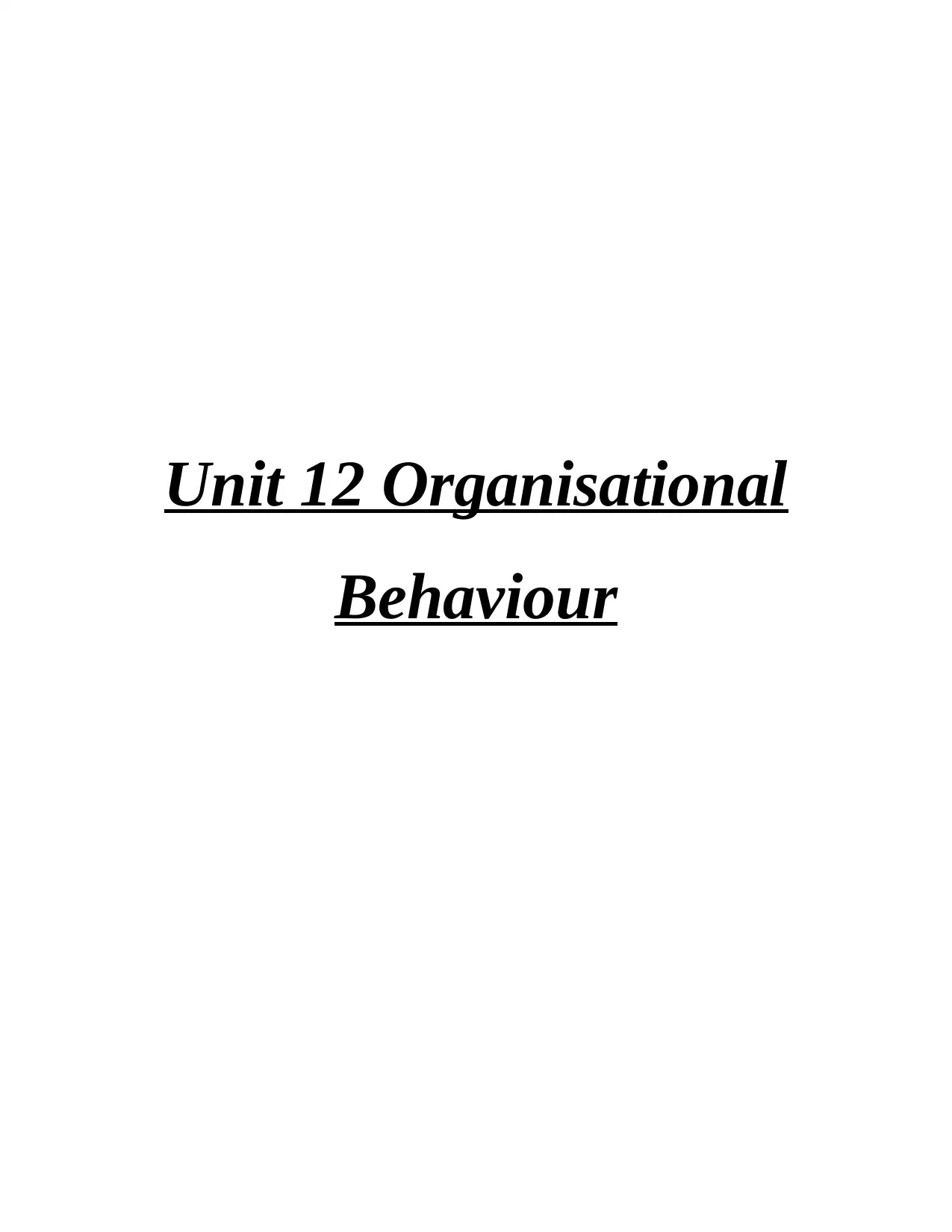
Unit 12 Organisational
Behaviour
Behaviour
Paraphrase This Document
Need a fresh take? Get an instant paraphrase of this document with our AI Paraphraser
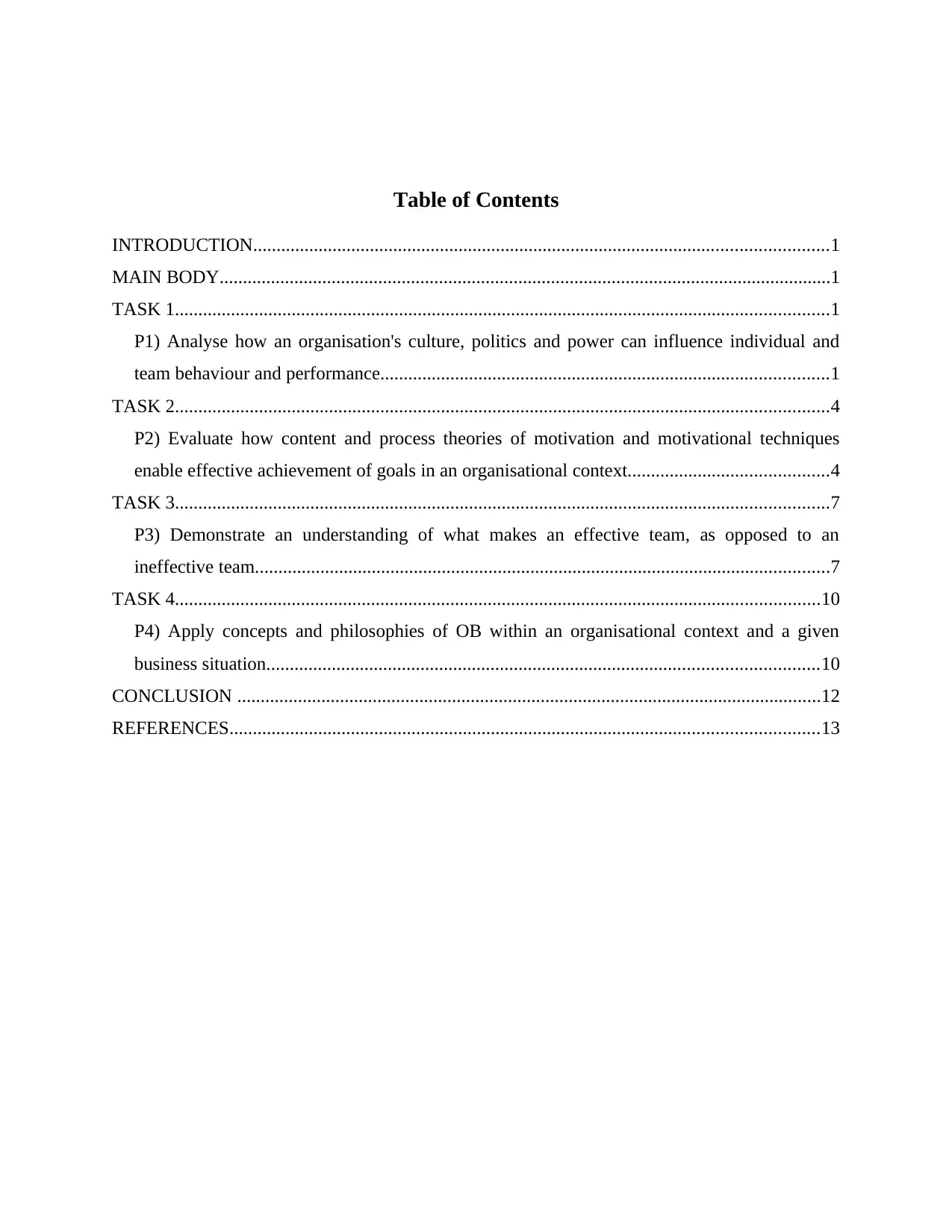
Table of Contents
INTRODUCTION...........................................................................................................................1
MAIN BODY...................................................................................................................................1
TASK 1............................................................................................................................................1
P1) Analyse how an organisation's culture, politics and power can influence individual and
team behaviour and performance................................................................................................1
TASK 2............................................................................................................................................4
P2) Evaluate how content and process theories of motivation and motivational techniques
enable effective achievement of goals in an organisational context...........................................4
TASK 3............................................................................................................................................7
P3) Demonstrate an understanding of what makes an effective team, as opposed to an
ineffective team...........................................................................................................................7
TASK 4..........................................................................................................................................10
P4) Apply concepts and philosophies of OB within an organisational context and a given
business situation......................................................................................................................10
CONCLUSION .............................................................................................................................12
REFERENCES..............................................................................................................................13
INTRODUCTION...........................................................................................................................1
MAIN BODY...................................................................................................................................1
TASK 1............................................................................................................................................1
P1) Analyse how an organisation's culture, politics and power can influence individual and
team behaviour and performance................................................................................................1
TASK 2............................................................................................................................................4
P2) Evaluate how content and process theories of motivation and motivational techniques
enable effective achievement of goals in an organisational context...........................................4
TASK 3............................................................................................................................................7
P3) Demonstrate an understanding of what makes an effective team, as opposed to an
ineffective team...........................................................................................................................7
TASK 4..........................................................................................................................................10
P4) Apply concepts and philosophies of OB within an organisational context and a given
business situation......................................................................................................................10
CONCLUSION .............................................................................................................................12
REFERENCES..............................................................................................................................13
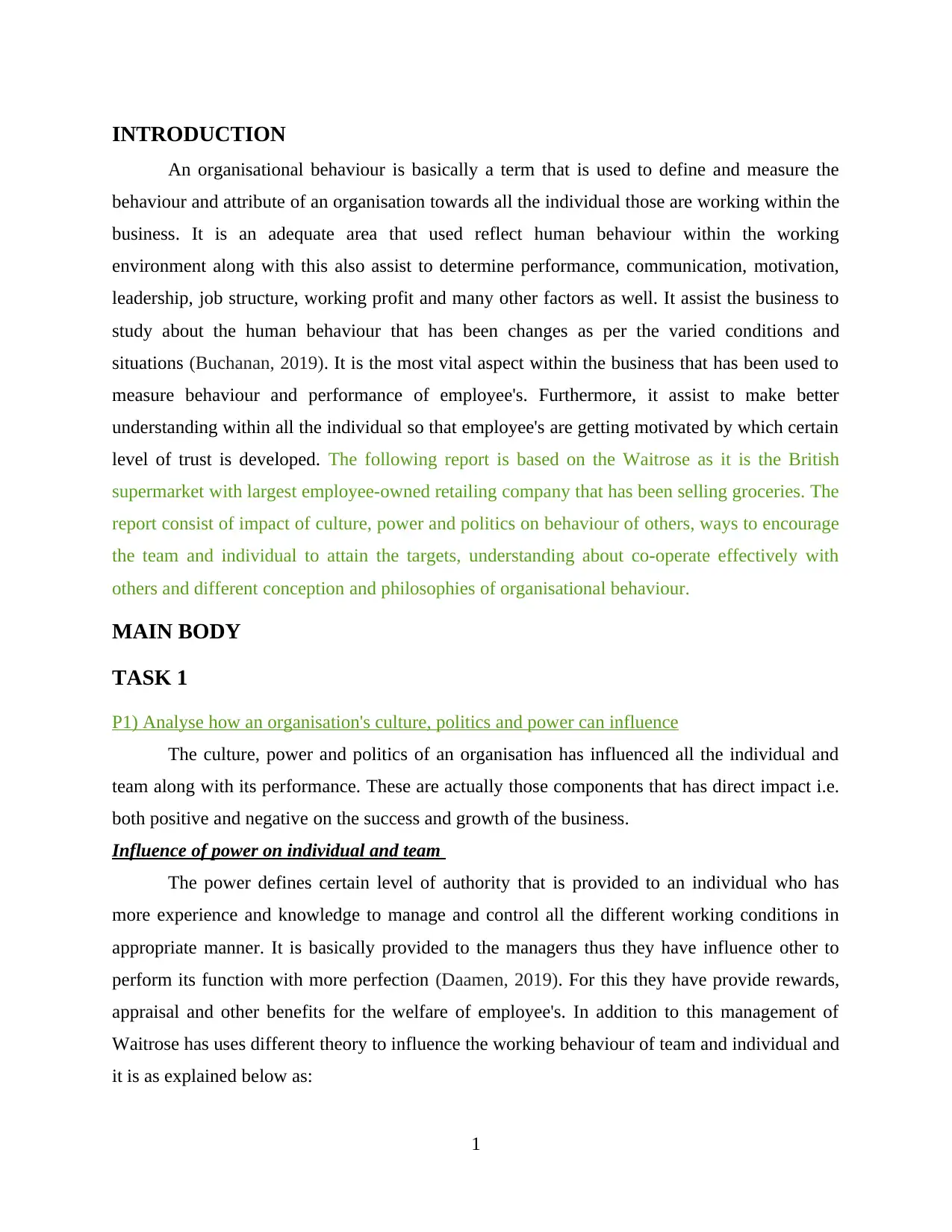
INTRODUCTION
An organisational behaviour is basically a term that is used to define and measure the
behaviour and attribute of an organisation towards all the individual those are working within the
business. It is an adequate area that used reflect human behaviour within the working
environment along with this also assist to determine performance, communication, motivation,
leadership, job structure, working profit and many other factors as well. It assist the business to
study about the human behaviour that has been changes as per the varied conditions and
situations (Buchanan, 2019). It is the most vital aspect within the business that has been used to
measure behaviour and performance of employee's. Furthermore, it assist to make better
understanding within all the individual so that employee's are getting motivated by which certain
level of trust is developed. The following report is based on the Waitrose as it is the British
supermarket with largest employee-owned retailing company that has been selling groceries. The
report consist of impact of culture, power and politics on behaviour of others, ways to encourage
the team and individual to attain the targets, understanding about co-operate effectively with
others and different conception and philosophies of organisational behaviour.
MAIN BODY
TASK 1
P1) Analyse how an organisation's culture, politics and power can influence
The culture, power and politics of an organisation has influenced all the individual and
team along with its performance. These are actually those components that has direct impact i.e.
both positive and negative on the success and growth of the business.
Influence of power on individual and team
The power defines certain level of authority that is provided to an individual who has
more experience and knowledge to manage and control all the different working conditions in
appropriate manner. It is basically provided to the managers thus they have influence other to
perform its function with more perfection (Daamen, 2019). For this they have provide rewards,
appraisal and other benefits for the welfare of employee's. In addition to this management of
Waitrose has uses different theory to influence the working behaviour of team and individual and
it is as explained below as:
1
An organisational behaviour is basically a term that is used to define and measure the
behaviour and attribute of an organisation towards all the individual those are working within the
business. It is an adequate area that used reflect human behaviour within the working
environment along with this also assist to determine performance, communication, motivation,
leadership, job structure, working profit and many other factors as well. It assist the business to
study about the human behaviour that has been changes as per the varied conditions and
situations (Buchanan, 2019). It is the most vital aspect within the business that has been used to
measure behaviour and performance of employee's. Furthermore, it assist to make better
understanding within all the individual so that employee's are getting motivated by which certain
level of trust is developed. The following report is based on the Waitrose as it is the British
supermarket with largest employee-owned retailing company that has been selling groceries. The
report consist of impact of culture, power and politics on behaviour of others, ways to encourage
the team and individual to attain the targets, understanding about co-operate effectively with
others and different conception and philosophies of organisational behaviour.
MAIN BODY
TASK 1
P1) Analyse how an organisation's culture, politics and power can influence
The culture, power and politics of an organisation has influenced all the individual and
team along with its performance. These are actually those components that has direct impact i.e.
both positive and negative on the success and growth of the business.
Influence of power on individual and team
The power defines certain level of authority that is provided to an individual who has
more experience and knowledge to manage and control all the different working conditions in
appropriate manner. It is basically provided to the managers thus they have influence other to
perform its function with more perfection (Daamen, 2019). For this they have provide rewards,
appraisal and other benefits for the welfare of employee's. In addition to this management of
Waitrose has uses different theory to influence the working behaviour of team and individual and
it is as explained below as:
1
⊘ This is a preview!⊘
Do you want full access?
Subscribe today to unlock all pages.

Trusted by 1+ million students worldwide
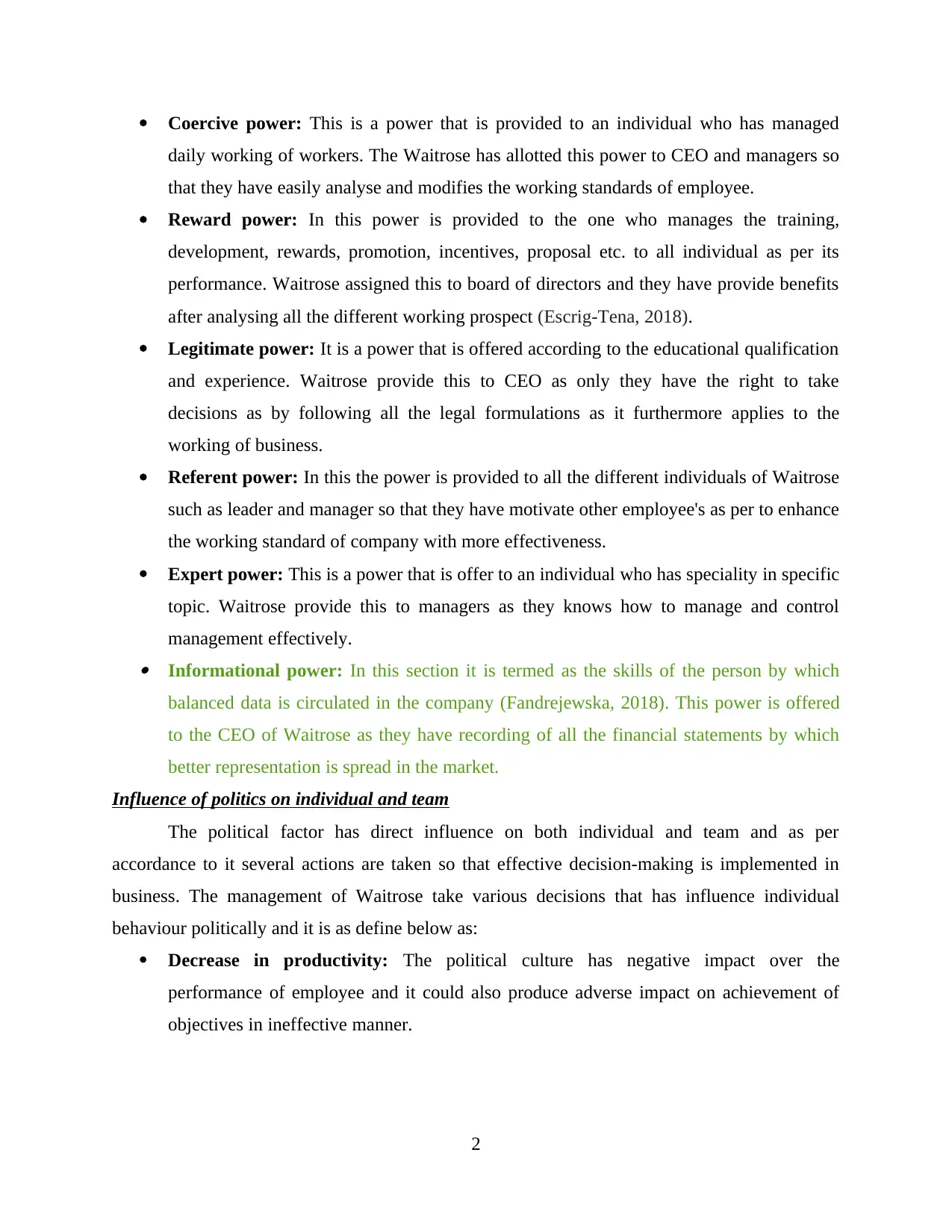
Coercive power: This is a power that is provided to an individual who has managed
daily working of workers. The Waitrose has allotted this power to CEO and managers so
that they have easily analyse and modifies the working standards of employee.
Reward power: In this power is provided to the one who manages the training,
development, rewards, promotion, incentives, proposal etc. to all individual as per its
performance. Waitrose assigned this to board of directors and they have provide benefits
after analysing all the different working prospect (Escrig-Tena, 2018).
Legitimate power: It is a power that is offered according to the educational qualification
and experience. Waitrose provide this to CEO as only they have the right to take
decisions as by following all the legal formulations as it furthermore applies to the
working of business.
Referent power: In this the power is provided to all the different individuals of Waitrose
such as leader and manager so that they have motivate other employee's as per to enhance
the working standard of company with more effectiveness.
Expert power: This is a power that is offer to an individual who has speciality in specific
topic. Waitrose provide this to managers as they knows how to manage and control
management effectively. Informational power: In this section it is termed as the skills of the person by which
balanced data is circulated in the company (Fandrejewska, 2018). This power is offered
to the CEO of Waitrose as they have recording of all the financial statements by which
better representation is spread in the market.
Influence of politics on individual and team
The political factor has direct influence on both individual and team and as per
accordance to it several actions are taken so that effective decision-making is implemented in
business. The management of Waitrose take various decisions that has influence individual
behaviour politically and it is as define below as:
Decrease in productivity: The political culture has negative impact over the
performance of employee and it could also produce adverse impact on achievement of
objectives in ineffective manner.
2
daily working of workers. The Waitrose has allotted this power to CEO and managers so
that they have easily analyse and modifies the working standards of employee.
Reward power: In this power is provided to the one who manages the training,
development, rewards, promotion, incentives, proposal etc. to all individual as per its
performance. Waitrose assigned this to board of directors and they have provide benefits
after analysing all the different working prospect (Escrig-Tena, 2018).
Legitimate power: It is a power that is offered according to the educational qualification
and experience. Waitrose provide this to CEO as only they have the right to take
decisions as by following all the legal formulations as it furthermore applies to the
working of business.
Referent power: In this the power is provided to all the different individuals of Waitrose
such as leader and manager so that they have motivate other employee's as per to enhance
the working standard of company with more effectiveness.
Expert power: This is a power that is offer to an individual who has speciality in specific
topic. Waitrose provide this to managers as they knows how to manage and control
management effectively. Informational power: In this section it is termed as the skills of the person by which
balanced data is circulated in the company (Fandrejewska, 2018). This power is offered
to the CEO of Waitrose as they have recording of all the financial statements by which
better representation is spread in the market.
Influence of politics on individual and team
The political factor has direct influence on both individual and team and as per
accordance to it several actions are taken so that effective decision-making is implemented in
business. The management of Waitrose take various decisions that has influence individual
behaviour politically and it is as define below as:
Decrease in productivity: The political culture has negative impact over the
performance of employee and it could also produce adverse impact on achievement of
objectives in ineffective manner.
2
Paraphrase This Document
Need a fresh take? Get an instant paraphrase of this document with our AI Paraphraser
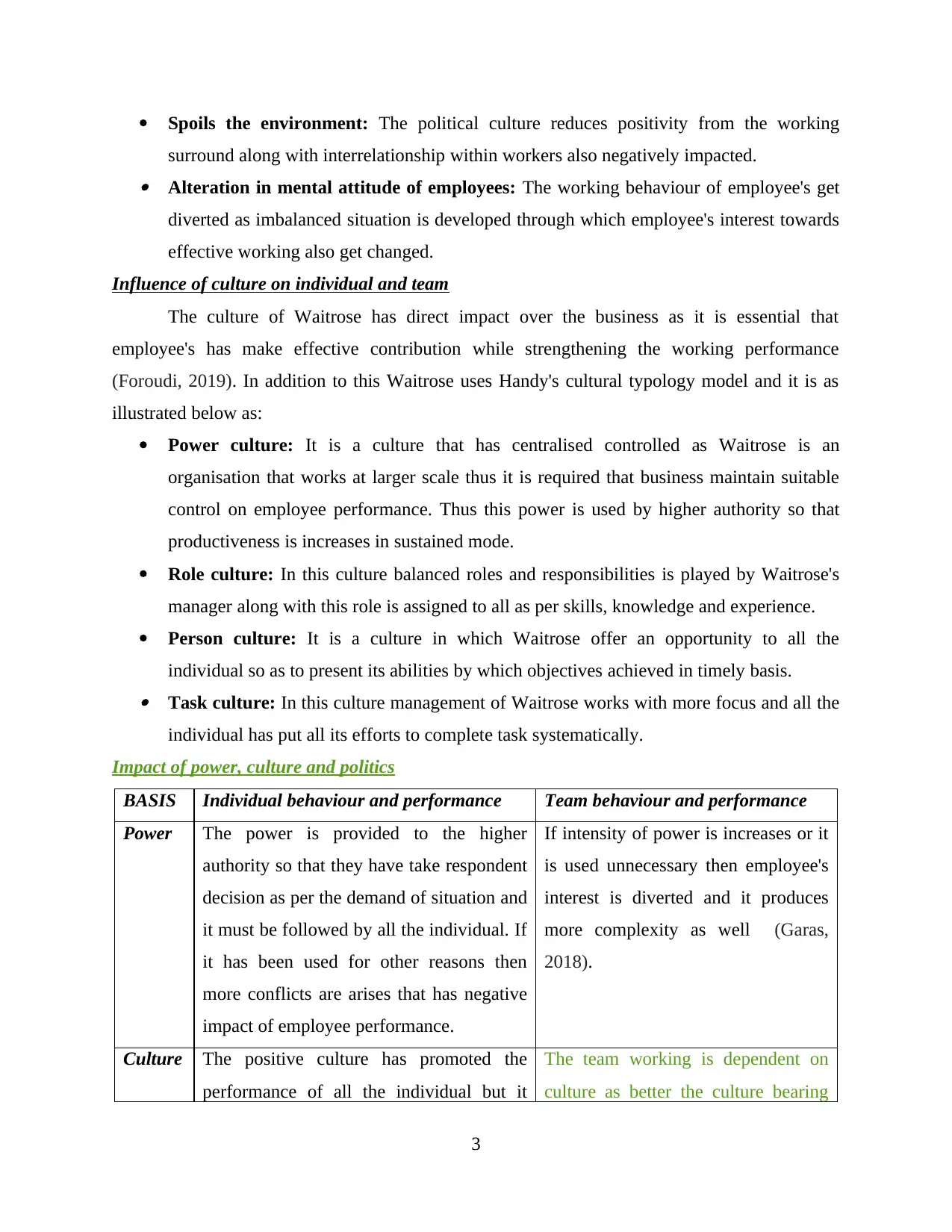
Spoils the environment: The political culture reduces positivity from the working
surround along with interrelationship within workers also negatively impacted. Alteration in mental attitude of employees: The working behaviour of employee's get
diverted as imbalanced situation is developed through which employee's interest towards
effective working also get changed.
Influence of culture on individual and team
The culture of Waitrose has direct impact over the business as it is essential that
employee's has make effective contribution while strengthening the working performance
(Foroudi, 2019). In addition to this Waitrose uses Handy's cultural typology model and it is as
illustrated below as:
Power culture: It is a culture that has centralised controlled as Waitrose is an
organisation that works at larger scale thus it is required that business maintain suitable
control on employee performance. Thus this power is used by higher authority so that
productiveness is increases in sustained mode.
Role culture: In this culture balanced roles and responsibilities is played by Waitrose's
manager along with this role is assigned to all as per skills, knowledge and experience.
Person culture: It is a culture in which Waitrose offer an opportunity to all the
individual so as to present its abilities by which objectives achieved in timely basis. Task culture: In this culture management of Waitrose works with more focus and all the
individual has put all its efforts to complete task systematically.
Impact of power, culture and politics
BASIS Individual behaviour and performance Team behaviour and performance
Power The power is provided to the higher
authority so that they have take respondent
decision as per the demand of situation and
it must be followed by all the individual. If
it has been used for other reasons then
more conflicts are arises that has negative
impact of employee performance.
If intensity of power is increases or it
is used unnecessary then employee's
interest is diverted and it produces
more complexity as well (Garas,
2018).
Culture The positive culture has promoted the
performance of all the individual but it
The team working is dependent on
culture as better the culture bearing
3
surround along with interrelationship within workers also negatively impacted. Alteration in mental attitude of employees: The working behaviour of employee's get
diverted as imbalanced situation is developed through which employee's interest towards
effective working also get changed.
Influence of culture on individual and team
The culture of Waitrose has direct impact over the business as it is essential that
employee's has make effective contribution while strengthening the working performance
(Foroudi, 2019). In addition to this Waitrose uses Handy's cultural typology model and it is as
illustrated below as:
Power culture: It is a culture that has centralised controlled as Waitrose is an
organisation that works at larger scale thus it is required that business maintain suitable
control on employee performance. Thus this power is used by higher authority so that
productiveness is increases in sustained mode.
Role culture: In this culture balanced roles and responsibilities is played by Waitrose's
manager along with this role is assigned to all as per skills, knowledge and experience.
Person culture: It is a culture in which Waitrose offer an opportunity to all the
individual so as to present its abilities by which objectives achieved in timely basis. Task culture: In this culture management of Waitrose works with more focus and all the
individual has put all its efforts to complete task systematically.
Impact of power, culture and politics
BASIS Individual behaviour and performance Team behaviour and performance
Power The power is provided to the higher
authority so that they have take respondent
decision as per the demand of situation and
it must be followed by all the individual. If
it has been used for other reasons then
more conflicts are arises that has negative
impact of employee performance.
If intensity of power is increases or it
is used unnecessary then employee's
interest is diverted and it produces
more complexity as well (Garas,
2018).
Culture The positive culture has promoted the
performance of all the individual but it
The team working is dependent on
culture as better the culture bearing
3
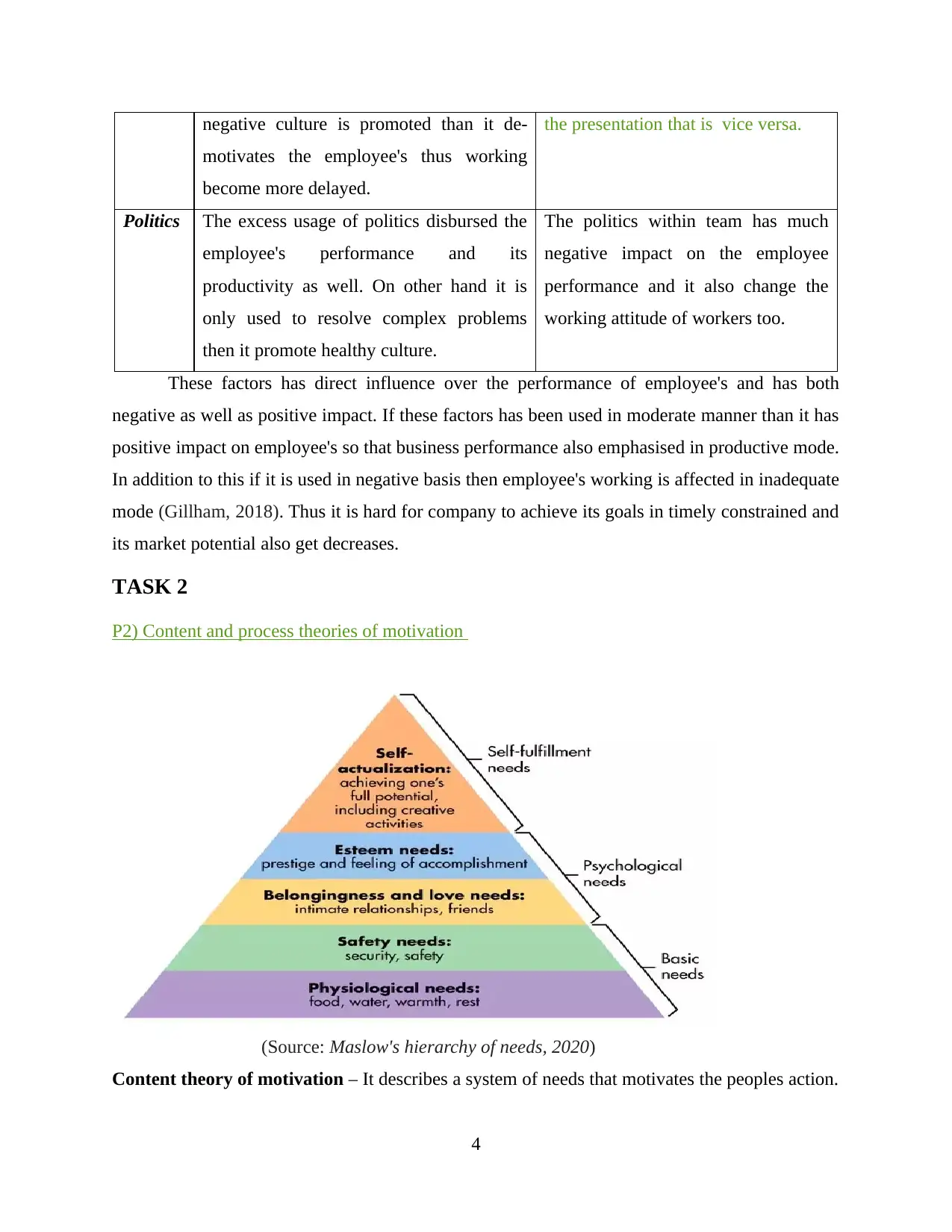
negative culture is promoted than it de-
motivates the employee's thus working
become more delayed.
the presentation that is vice versa.
Politics The excess usage of politics disbursed the
employee's performance and its
productivity as well. On other hand it is
only used to resolve complex problems
then it promote healthy culture.
The politics within team has much
negative impact on the employee
performance and it also change the
working attitude of workers too.
These factors has direct influence over the performance of employee's and has both
negative as well as positive impact. If these factors has been used in moderate manner than it has
positive impact on employee's so that business performance also emphasised in productive mode.
In addition to this if it is used in negative basis then employee's working is affected in inadequate
mode (Gillham, 2018). Thus it is hard for company to achieve its goals in timely constrained and
its market potential also get decreases.
TASK 2
P2) Content and process theories of motivation
(Source: Maslow's hierarchy of needs, 2020)
Content theory of motivation – It describes a system of needs that motivates the peoples action.
4
motivates the employee's thus working
become more delayed.
the presentation that is vice versa.
Politics The excess usage of politics disbursed the
employee's performance and its
productivity as well. On other hand it is
only used to resolve complex problems
then it promote healthy culture.
The politics within team has much
negative impact on the employee
performance and it also change the
working attitude of workers too.
These factors has direct influence over the performance of employee's and has both
negative as well as positive impact. If these factors has been used in moderate manner than it has
positive impact on employee's so that business performance also emphasised in productive mode.
In addition to this if it is used in negative basis then employee's working is affected in inadequate
mode (Gillham, 2018). Thus it is hard for company to achieve its goals in timely constrained and
its market potential also get decreases.
TASK 2
P2) Content and process theories of motivation
(Source: Maslow's hierarchy of needs, 2020)
Content theory of motivation – It describes a system of needs that motivates the peoples action.
4
⊘ This is a preview!⊘
Do you want full access?
Subscribe today to unlock all pages.

Trusted by 1+ million students worldwide
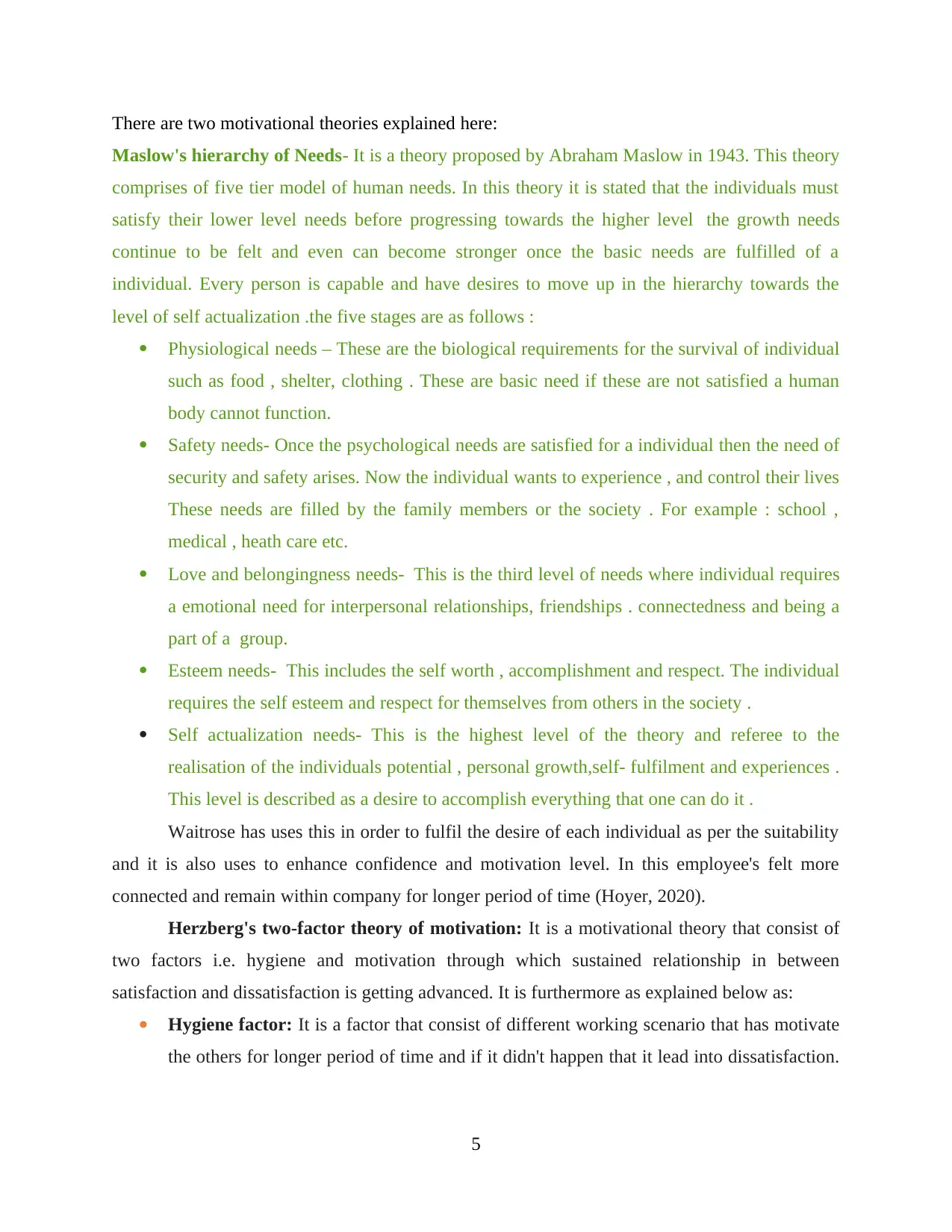
There are two motivational theories explained here:
Maslow's hierarchy of Needs- It is a theory proposed by Abraham Maslow in 1943. This theory
comprises of five tier model of human needs. In this theory it is stated that the individuals must
satisfy their lower level needs before progressing towards the higher level the growth needs
continue to be felt and even can become stronger once the basic needs are fulfilled of a
individual. Every person is capable and have desires to move up in the hierarchy towards the
level of self actualization .the five stages are as follows :
Physiological needs – These are the biological requirements for the survival of individual
such as food , shelter, clothing . These are basic need if these are not satisfied a human
body cannot function.
Safety needs- Once the psychological needs are satisfied for a individual then the need of
security and safety arises. Now the individual wants to experience , and control their lives
These needs are filled by the family members or the society . For example : school ,
medical , heath care etc.
Love and belongingness needs- This is the third level of needs where individual requires
a emotional need for interpersonal relationships, friendships . connectedness and being a
part of a group.
Esteem needs- This includes the self worth , accomplishment and respect. The individual
requires the self esteem and respect for themselves from others in the society .
Self actualization needs- This is the highest level of the theory and referee to the
realisation of the individuals potential , personal growth,self- fulfilment and experiences .
This level is described as a desire to accomplish everything that one can do it .
Waitrose has uses this in order to fulfil the desire of each individual as per the suitability
and it is also uses to enhance confidence and motivation level. In this employee's felt more
connected and remain within company for longer period of time (Hoyer, 2020).
Herzberg's two-factor theory of motivation: It is a motivational theory that consist of
two factors i.e. hygiene and motivation through which sustained relationship in between
satisfaction and dissatisfaction is getting advanced. It is furthermore as explained below as:
Hygiene factor: It is a factor that consist of different working scenario that has motivate
the others for longer period of time and if it didn't happen that it lead into dissatisfaction.
5
Maslow's hierarchy of Needs- It is a theory proposed by Abraham Maslow in 1943. This theory
comprises of five tier model of human needs. In this theory it is stated that the individuals must
satisfy their lower level needs before progressing towards the higher level the growth needs
continue to be felt and even can become stronger once the basic needs are fulfilled of a
individual. Every person is capable and have desires to move up in the hierarchy towards the
level of self actualization .the five stages are as follows :
Physiological needs – These are the biological requirements for the survival of individual
such as food , shelter, clothing . These are basic need if these are not satisfied a human
body cannot function.
Safety needs- Once the psychological needs are satisfied for a individual then the need of
security and safety arises. Now the individual wants to experience , and control their lives
These needs are filled by the family members or the society . For example : school ,
medical , heath care etc.
Love and belongingness needs- This is the third level of needs where individual requires
a emotional need for interpersonal relationships, friendships . connectedness and being a
part of a group.
Esteem needs- This includes the self worth , accomplishment and respect. The individual
requires the self esteem and respect for themselves from others in the society .
Self actualization needs- This is the highest level of the theory and referee to the
realisation of the individuals potential , personal growth,self- fulfilment and experiences .
This level is described as a desire to accomplish everything that one can do it .
Waitrose has uses this in order to fulfil the desire of each individual as per the suitability
and it is also uses to enhance confidence and motivation level. In this employee's felt more
connected and remain within company for longer period of time (Hoyer, 2020).
Herzberg's two-factor theory of motivation: It is a motivational theory that consist of
two factors i.e. hygiene and motivation through which sustained relationship in between
satisfaction and dissatisfaction is getting advanced. It is furthermore as explained below as:
Hygiene factor: It is a factor that consist of different working scenario that has motivate
the others for longer period of time and if it didn't happen that it lead into dissatisfaction.
5
Paraphrase This Document
Need a fresh take? Get an instant paraphrase of this document with our AI Paraphraser
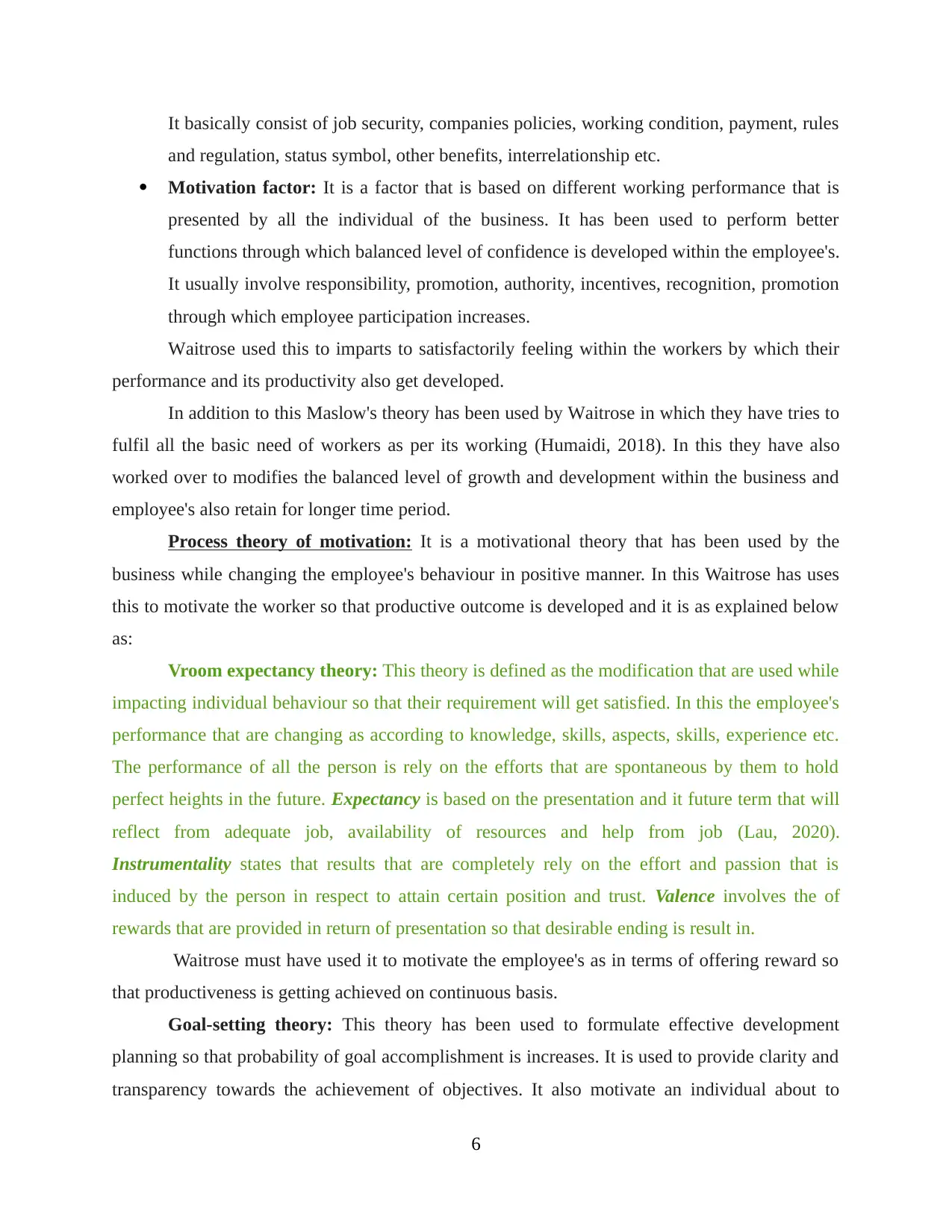
It basically consist of job security, companies policies, working condition, payment, rules
and regulation, status symbol, other benefits, interrelationship etc.
Motivation factor: It is a factor that is based on different working performance that is
presented by all the individual of the business. It has been used to perform better
functions through which balanced level of confidence is developed within the employee's.
It usually involve responsibility, promotion, authority, incentives, recognition, promotion
through which employee participation increases.
Waitrose used this to imparts to satisfactorily feeling within the workers by which their
performance and its productivity also get developed.
In addition to this Maslow's theory has been used by Waitrose in which they have tries to
fulfil all the basic need of workers as per its working (Humaidi, 2018). In this they have also
worked over to modifies the balanced level of growth and development within the business and
employee's also retain for longer time period.
Process theory of motivation: It is a motivational theory that has been used by the
business while changing the employee's behaviour in positive manner. In this Waitrose has uses
this to motivate the worker so that productive outcome is developed and it is as explained below
as:
Vroom expectancy theory: This theory is defined as the modification that are used while
impacting individual behaviour so that their requirement will get satisfied. In this the employee's
performance that are changing as according to knowledge, skills, aspects, skills, experience etc.
The performance of all the person is rely on the efforts that are spontaneous by them to hold
perfect heights in the future. Expectancy is based on the presentation and it future term that will
reflect from adequate job, availability of resources and help from job (Lau, 2020).
Instrumentality states that results that are completely rely on the effort and passion that is
induced by the person in respect to attain certain position and trust. Valence involves the of
rewards that are provided in return of presentation so that desirable ending is result in.
Waitrose must have used it to motivate the employee's as in terms of offering reward so
that productiveness is getting achieved on continuous basis.
Goal-setting theory: This theory has been used to formulate effective development
planning so that probability of goal accomplishment is increases. It is used to provide clarity and
transparency towards the achievement of objectives. It also motivate an individual about to
6
and regulation, status symbol, other benefits, interrelationship etc.
Motivation factor: It is a factor that is based on different working performance that is
presented by all the individual of the business. It has been used to perform better
functions through which balanced level of confidence is developed within the employee's.
It usually involve responsibility, promotion, authority, incentives, recognition, promotion
through which employee participation increases.
Waitrose used this to imparts to satisfactorily feeling within the workers by which their
performance and its productivity also get developed.
In addition to this Maslow's theory has been used by Waitrose in which they have tries to
fulfil all the basic need of workers as per its working (Humaidi, 2018). In this they have also
worked over to modifies the balanced level of growth and development within the business and
employee's also retain for longer time period.
Process theory of motivation: It is a motivational theory that has been used by the
business while changing the employee's behaviour in positive manner. In this Waitrose has uses
this to motivate the worker so that productive outcome is developed and it is as explained below
as:
Vroom expectancy theory: This theory is defined as the modification that are used while
impacting individual behaviour so that their requirement will get satisfied. In this the employee's
performance that are changing as according to knowledge, skills, aspects, skills, experience etc.
The performance of all the person is rely on the efforts that are spontaneous by them to hold
perfect heights in the future. Expectancy is based on the presentation and it future term that will
reflect from adequate job, availability of resources and help from job (Lau, 2020).
Instrumentality states that results that are completely rely on the effort and passion that is
induced by the person in respect to attain certain position and trust. Valence involves the of
rewards that are provided in return of presentation so that desirable ending is result in.
Waitrose must have used it to motivate the employee's as in terms of offering reward so
that productiveness is getting achieved on continuous basis.
Goal-setting theory: This theory has been used to formulate effective development
planning so that probability of goal accomplishment is increases. It is used to provide clarity and
transparency towards the achievement of objectives. It also motivate an individual about to
6
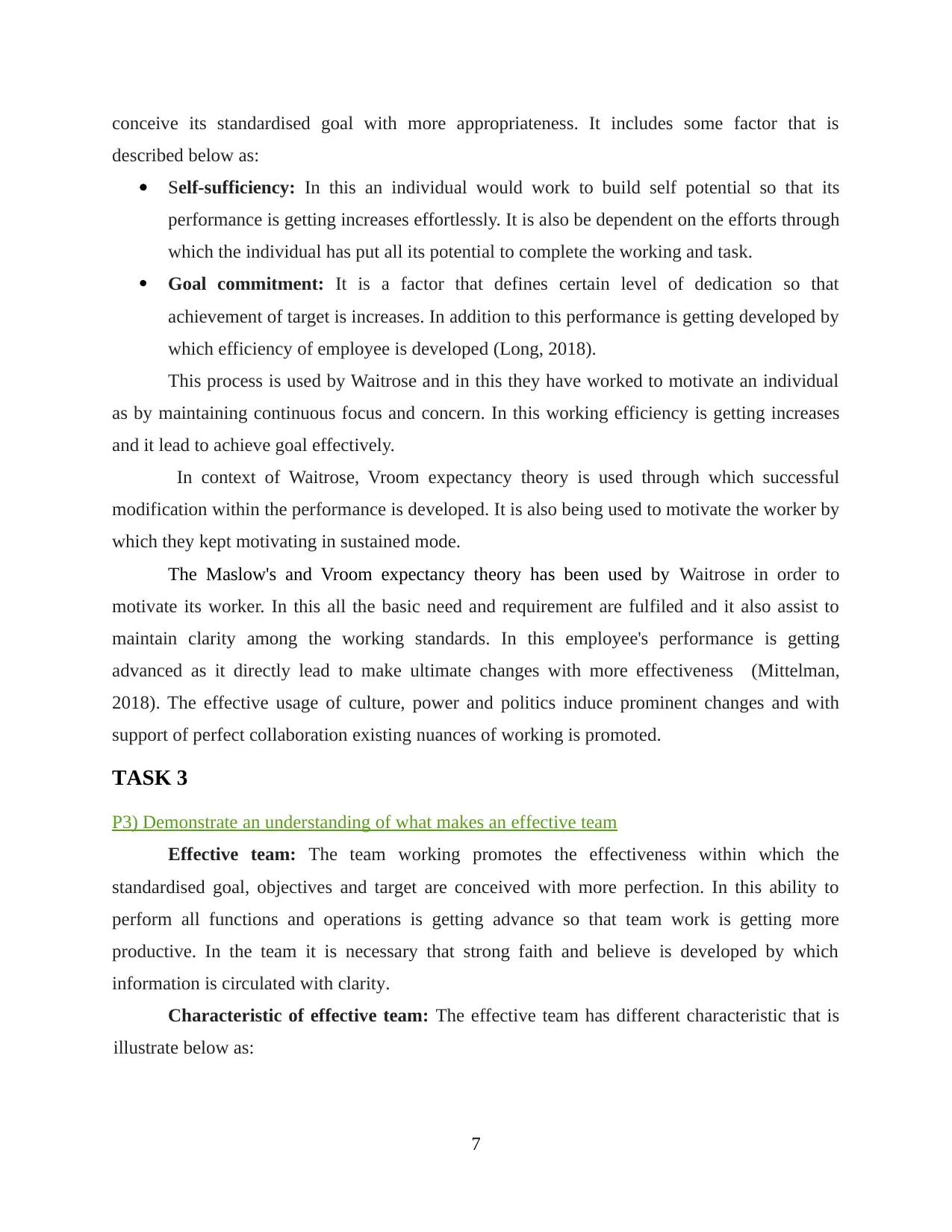
conceive its standardised goal with more appropriateness. It includes some factor that is
described below as:
Self-sufficiency: In this an individual would work to build self potential so that its
performance is getting increases effortlessly. It is also be dependent on the efforts through
which the individual has put all its potential to complete the working and task.
Goal commitment: It is a factor that defines certain level of dedication so that
achievement of target is increases. In addition to this performance is getting developed by
which efficiency of employee is developed (Long, 2018).
This process is used by Waitrose and in this they have worked to motivate an individual
as by maintaining continuous focus and concern. In this working efficiency is getting increases
and it lead to achieve goal effectively.
In context of Waitrose, Vroom expectancy theory is used through which successful
modification within the performance is developed. It is also being used to motivate the worker by
which they kept motivating in sustained mode.
The Maslow's and Vroom expectancy theory has been used by Waitrose in order to
motivate its worker. In this all the basic need and requirement are fulfiled and it also assist to
maintain clarity among the working standards. In this employee's performance is getting
advanced as it directly lead to make ultimate changes with more effectiveness (Mittelman,
2018). The effective usage of culture, power and politics induce prominent changes and with
support of perfect collaboration existing nuances of working is promoted.
TASK 3
P3) Demonstrate an understanding of what makes an effective team
Effective team: The team working promotes the effectiveness within which the
standardised goal, objectives and target are conceived with more perfection. In this ability to
perform all functions and operations is getting advance so that team work is getting more
productive. In the team it is necessary that strong faith and believe is developed by which
information is circulated with clarity.
Characteristic of effective team: The effective team has different characteristic that is
illustrate below as:
7
described below as:
Self-sufficiency: In this an individual would work to build self potential so that its
performance is getting increases effortlessly. It is also be dependent on the efforts through
which the individual has put all its potential to complete the working and task.
Goal commitment: It is a factor that defines certain level of dedication so that
achievement of target is increases. In addition to this performance is getting developed by
which efficiency of employee is developed (Long, 2018).
This process is used by Waitrose and in this they have worked to motivate an individual
as by maintaining continuous focus and concern. In this working efficiency is getting increases
and it lead to achieve goal effectively.
In context of Waitrose, Vroom expectancy theory is used through which successful
modification within the performance is developed. It is also being used to motivate the worker by
which they kept motivating in sustained mode.
The Maslow's and Vroom expectancy theory has been used by Waitrose in order to
motivate its worker. In this all the basic need and requirement are fulfiled and it also assist to
maintain clarity among the working standards. In this employee's performance is getting
advanced as it directly lead to make ultimate changes with more effectiveness (Mittelman,
2018). The effective usage of culture, power and politics induce prominent changes and with
support of perfect collaboration existing nuances of working is promoted.
TASK 3
P3) Demonstrate an understanding of what makes an effective team
Effective team: The team working promotes the effectiveness within which the
standardised goal, objectives and target are conceived with more perfection. In this ability to
perform all functions and operations is getting advance so that team work is getting more
productive. In the team it is necessary that strong faith and believe is developed by which
information is circulated with clarity.
Characteristic of effective team: The effective team has different characteristic that is
illustrate below as:
7
⊘ This is a preview!⊘
Do you want full access?
Subscribe today to unlock all pages.

Trusted by 1+ million students worldwide
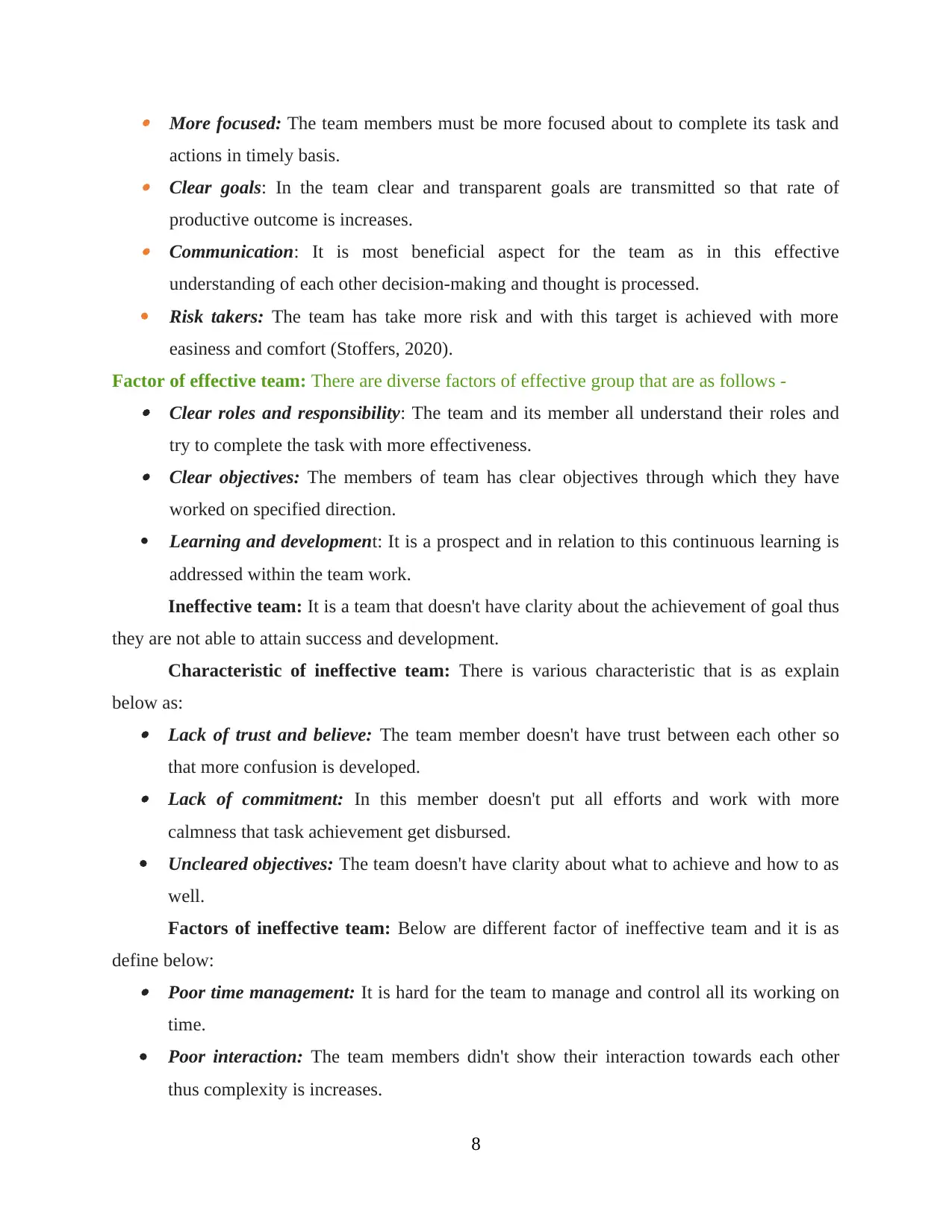
More focused: The team members must be more focused about to complete its task and
actions in timely basis. Clear goals: In the team clear and transparent goals are transmitted so that rate of
productive outcome is increases. Communication: It is most beneficial aspect for the team as in this effective
understanding of each other decision-making and thought is processed.
Risk takers: The team has take more risk and with this target is achieved with more
easiness and comfort (Stoffers, 2020).
Factor of effective team: There are diverse factors of effective group that are as follows - Clear roles and responsibility: The team and its member all understand their roles and
try to complete the task with more effectiveness. Clear objectives: The members of team has clear objectives through which they have
worked on specified direction.
Learning and development: It is a prospect and in relation to this continuous learning is
addressed within the team work.
Ineffective team: It is a team that doesn't have clarity about the achievement of goal thus
they are not able to attain success and development.
Characteristic of ineffective team: There is various characteristic that is as explain
below as: Lack of trust and believe: The team member doesn't have trust between each other so
that more confusion is developed. Lack of commitment: In this member doesn't put all efforts and work with more
calmness that task achievement get disbursed.
Uncleared objectives: The team doesn't have clarity about what to achieve and how to as
well.
Factors of ineffective team: Below are different factor of ineffective team and it is as
define below: Poor time management: It is hard for the team to manage and control all its working on
time.
Poor interaction: The team members didn't show their interaction towards each other
thus complexity is increases.
8
actions in timely basis. Clear goals: In the team clear and transparent goals are transmitted so that rate of
productive outcome is increases. Communication: It is most beneficial aspect for the team as in this effective
understanding of each other decision-making and thought is processed.
Risk takers: The team has take more risk and with this target is achieved with more
easiness and comfort (Stoffers, 2020).
Factor of effective team: There are diverse factors of effective group that are as follows - Clear roles and responsibility: The team and its member all understand their roles and
try to complete the task with more effectiveness. Clear objectives: The members of team has clear objectives through which they have
worked on specified direction.
Learning and development: It is a prospect and in relation to this continuous learning is
addressed within the team work.
Ineffective team: It is a team that doesn't have clarity about the achievement of goal thus
they are not able to attain success and development.
Characteristic of ineffective team: There is various characteristic that is as explain
below as: Lack of trust and believe: The team member doesn't have trust between each other so
that more confusion is developed. Lack of commitment: In this member doesn't put all efforts and work with more
calmness that task achievement get disbursed.
Uncleared objectives: The team doesn't have clarity about what to achieve and how to as
well.
Factors of ineffective team: Below are different factor of ineffective team and it is as
define below: Poor time management: It is hard for the team to manage and control all its working on
time.
Poor interaction: The team members didn't show their interaction towards each other
thus complexity is increases.
8
Paraphrase This Document
Need a fresh take? Get an instant paraphrase of this document with our AI Paraphraser
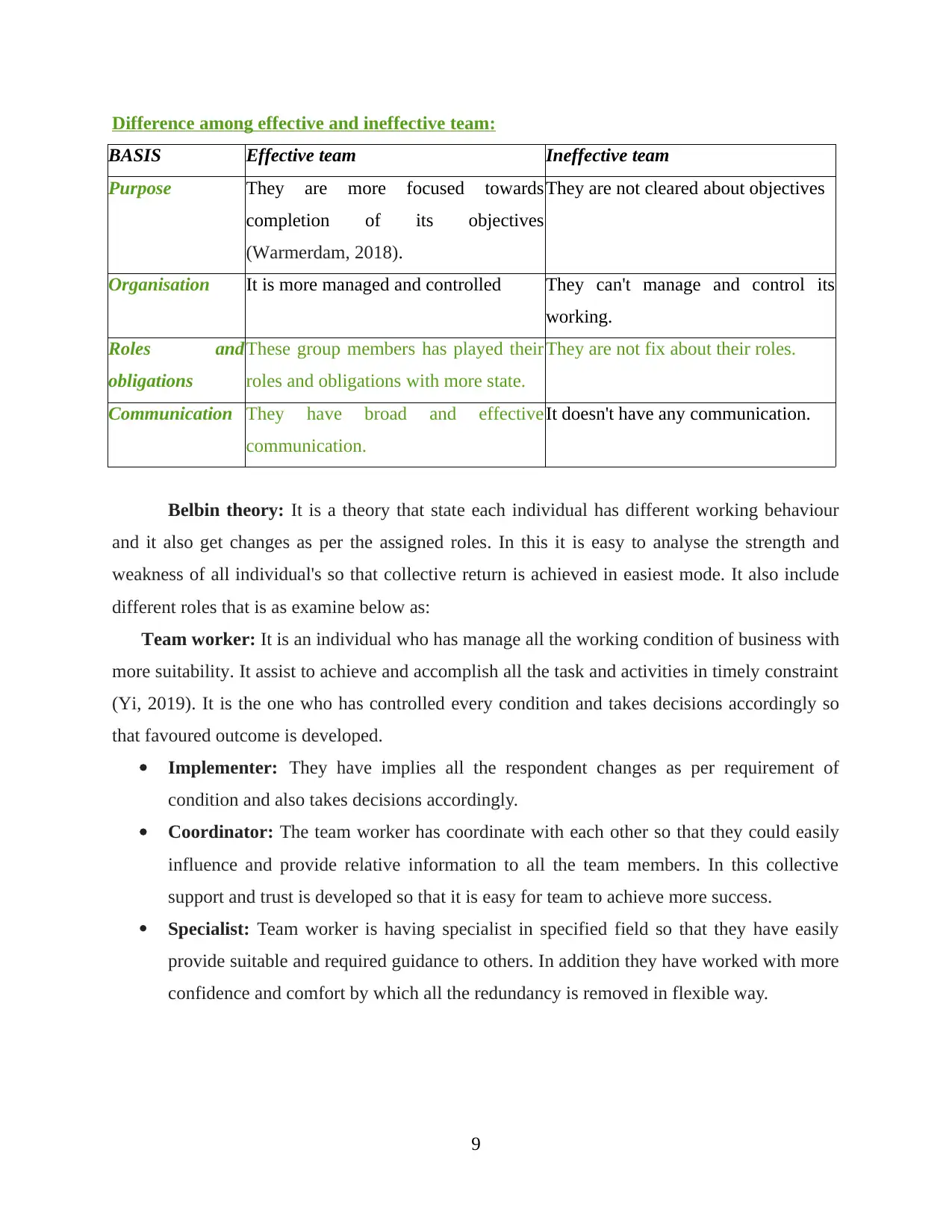
Difference among effective and ineffective team:
BASIS Effective team Ineffective team
Purpose They are more focused towards
completion of its objectives
(Warmerdam, 2018).
They are not cleared about objectives
Organisation It is more managed and controlled They can't manage and control its
working.
Roles and
obligations
These group members has played their
roles and obligations with more state.
They are not fix about their roles.
Communication They have broad and effective
communication.
It doesn't have any communication.
Belbin theory: It is a theory that state each individual has different working behaviour
and it also get changes as per the assigned roles. In this it is easy to analyse the strength and
weakness of all individual's so that collective return is achieved in easiest mode. It also include
different roles that is as examine below as:
Team worker: It is an individual who has manage all the working condition of business with
more suitability. It assist to achieve and accomplish all the task and activities in timely constraint
(Yi, 2019). It is the one who has controlled every condition and takes decisions accordingly so
that favoured outcome is developed.
Implementer: They have implies all the respondent changes as per requirement of
condition and also takes decisions accordingly.
Coordinator: The team worker has coordinate with each other so that they could easily
influence and provide relative information to all the team members. In this collective
support and trust is developed so that it is easy for team to achieve more success.
Specialist: Team worker is having specialist in specified field so that they have easily
provide suitable and required guidance to others. In addition they have worked with more
confidence and comfort by which all the redundancy is removed in flexible way.
9
BASIS Effective team Ineffective team
Purpose They are more focused towards
completion of its objectives
(Warmerdam, 2018).
They are not cleared about objectives
Organisation It is more managed and controlled They can't manage and control its
working.
Roles and
obligations
These group members has played their
roles and obligations with more state.
They are not fix about their roles.
Communication They have broad and effective
communication.
It doesn't have any communication.
Belbin theory: It is a theory that state each individual has different working behaviour
and it also get changes as per the assigned roles. In this it is easy to analyse the strength and
weakness of all individual's so that collective return is achieved in easiest mode. It also include
different roles that is as examine below as:
Team worker: It is an individual who has manage all the working condition of business with
more suitability. It assist to achieve and accomplish all the task and activities in timely constraint
(Yi, 2019). It is the one who has controlled every condition and takes decisions accordingly so
that favoured outcome is developed.
Implementer: They have implies all the respondent changes as per requirement of
condition and also takes decisions accordingly.
Coordinator: The team worker has coordinate with each other so that they could easily
influence and provide relative information to all the team members. In this collective
support and trust is developed so that it is easy for team to achieve more success.
Specialist: Team worker is having specialist in specified field so that they have easily
provide suitable and required guidance to others. In addition they have worked with more
confidence and comfort by which all the redundancy is removed in flexible way.
9
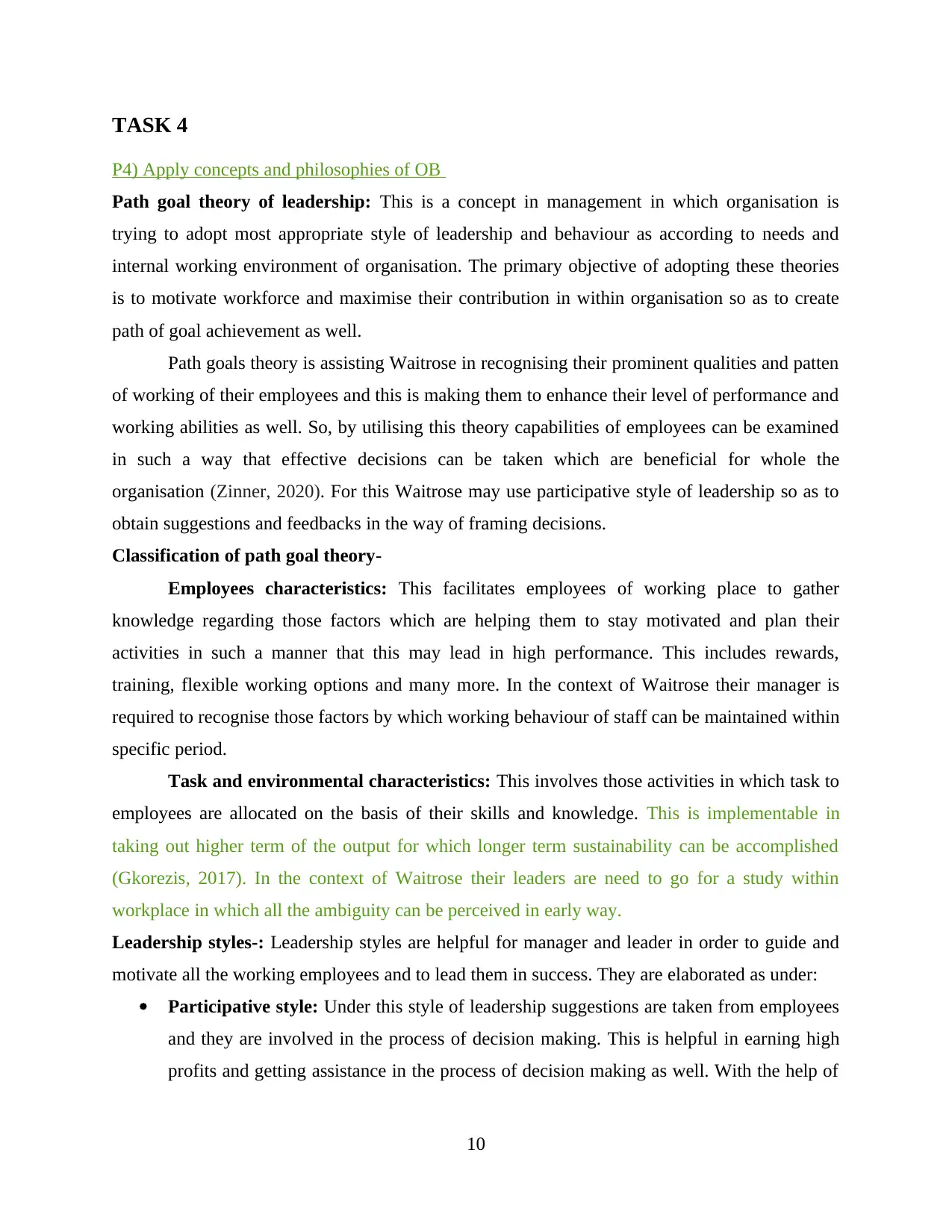
TASK 4
P4) Apply concepts and philosophies of OB
Path goal theory of leadership: This is a concept in management in which organisation is
trying to adopt most appropriate style of leadership and behaviour as according to needs and
internal working environment of organisation. The primary objective of adopting these theories
is to motivate workforce and maximise their contribution in within organisation so as to create
path of goal achievement as well.
Path goals theory is assisting Waitrose in recognising their prominent qualities and patten
of working of their employees and this is making them to enhance their level of performance and
working abilities as well. So, by utilising this theory capabilities of employees can be examined
in such a way that effective decisions can be taken which are beneficial for whole the
organisation (Zinner, 2020). For this Waitrose may use participative style of leadership so as to
obtain suggestions and feedbacks in the way of framing decisions.
Classification of path goal theory-
Employees characteristics: This facilitates employees of working place to gather
knowledge regarding those factors which are helping them to stay motivated and plan their
activities in such a manner that this may lead in high performance. This includes rewards,
training, flexible working options and many more. In the context of Waitrose their manager is
required to recognise those factors by which working behaviour of staff can be maintained within
specific period.
Task and environmental characteristics: This involves those activities in which task to
employees are allocated on the basis of their skills and knowledge. This is implementable in
taking out higher term of the output for which longer term sustainability can be accomplished
(Gkorezis, 2017). In the context of Waitrose their leaders are need to go for a study within
workplace in which all the ambiguity can be perceived in early way.
Leadership styles-: Leadership styles are helpful for manager and leader in order to guide and
motivate all the working employees and to lead them in success. They are elaborated as under:
Participative style: Under this style of leadership suggestions are taken from employees
and they are involved in the process of decision making. This is helpful in earning high
profits and getting assistance in the process of decision making as well. With the help of
10
P4) Apply concepts and philosophies of OB
Path goal theory of leadership: This is a concept in management in which organisation is
trying to adopt most appropriate style of leadership and behaviour as according to needs and
internal working environment of organisation. The primary objective of adopting these theories
is to motivate workforce and maximise their contribution in within organisation so as to create
path of goal achievement as well.
Path goals theory is assisting Waitrose in recognising their prominent qualities and patten
of working of their employees and this is making them to enhance their level of performance and
working abilities as well. So, by utilising this theory capabilities of employees can be examined
in such a way that effective decisions can be taken which are beneficial for whole the
organisation (Zinner, 2020). For this Waitrose may use participative style of leadership so as to
obtain suggestions and feedbacks in the way of framing decisions.
Classification of path goal theory-
Employees characteristics: This facilitates employees of working place to gather
knowledge regarding those factors which are helping them to stay motivated and plan their
activities in such a manner that this may lead in high performance. This includes rewards,
training, flexible working options and many more. In the context of Waitrose their manager is
required to recognise those factors by which working behaviour of staff can be maintained within
specific period.
Task and environmental characteristics: This involves those activities in which task to
employees are allocated on the basis of their skills and knowledge. This is implementable in
taking out higher term of the output for which longer term sustainability can be accomplished
(Gkorezis, 2017). In the context of Waitrose their leaders are need to go for a study within
workplace in which all the ambiguity can be perceived in early way.
Leadership styles-: Leadership styles are helpful for manager and leader in order to guide and
motivate all the working employees and to lead them in success. They are elaborated as under:
Participative style: Under this style of leadership suggestions are taken from employees
and they are involved in the process of decision making. This is helpful in earning high
profits and getting assistance in the process of decision making as well. With the help of
10
⊘ This is a preview!⊘
Do you want full access?
Subscribe today to unlock all pages.

Trusted by 1+ million students worldwide
1 out of 16
Related Documents
Your All-in-One AI-Powered Toolkit for Academic Success.
+13062052269
info@desklib.com
Available 24*7 on WhatsApp / Email
![[object Object]](/_next/static/media/star-bottom.7253800d.svg)
Unlock your academic potential
Copyright © 2020–2025 A2Z Services. All Rights Reserved. Developed and managed by ZUCOL.





